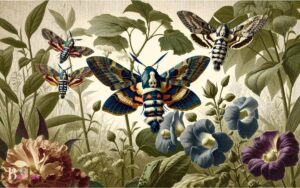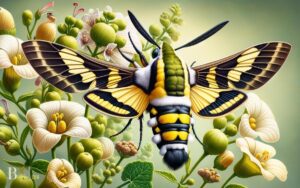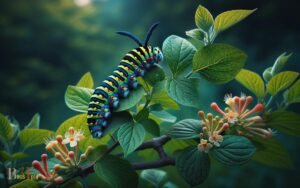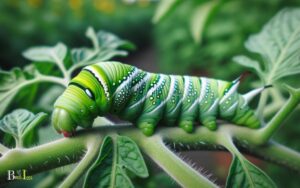Hummingbird Moth as a Caterpillar: Discover!
The hummingbird moth caterpillar, commonly referred to as a hornworm, is the larval stage of the hummingbird moth species.
This caterpillar can reach a length of up to 4 inches and is known for its striking green color with white diagonal stripes and a distinct horn-like spike at its posterior end.
It undergoes a series of molts as it grows, during which it will shed its skin multiple times to accommodate its larger size.
The hummingbird moth caterpillar is a voracious eater, consuming the foliage of host plants, which is essential for its metamorphosis into the adult moth.
This stage is crucial for understanding the life cycle of the hummingbird moth and highlights the diversity within the insect world.
The hummingbird moth caterpillar is an intriguing and distinctive creature that undergoes several stages of growth before reaching adulthood.
Key characteristics include:
Discovering the hummingbird moth caterpillar’s lifecycle is a glimpse into nature’s transformative marvels.
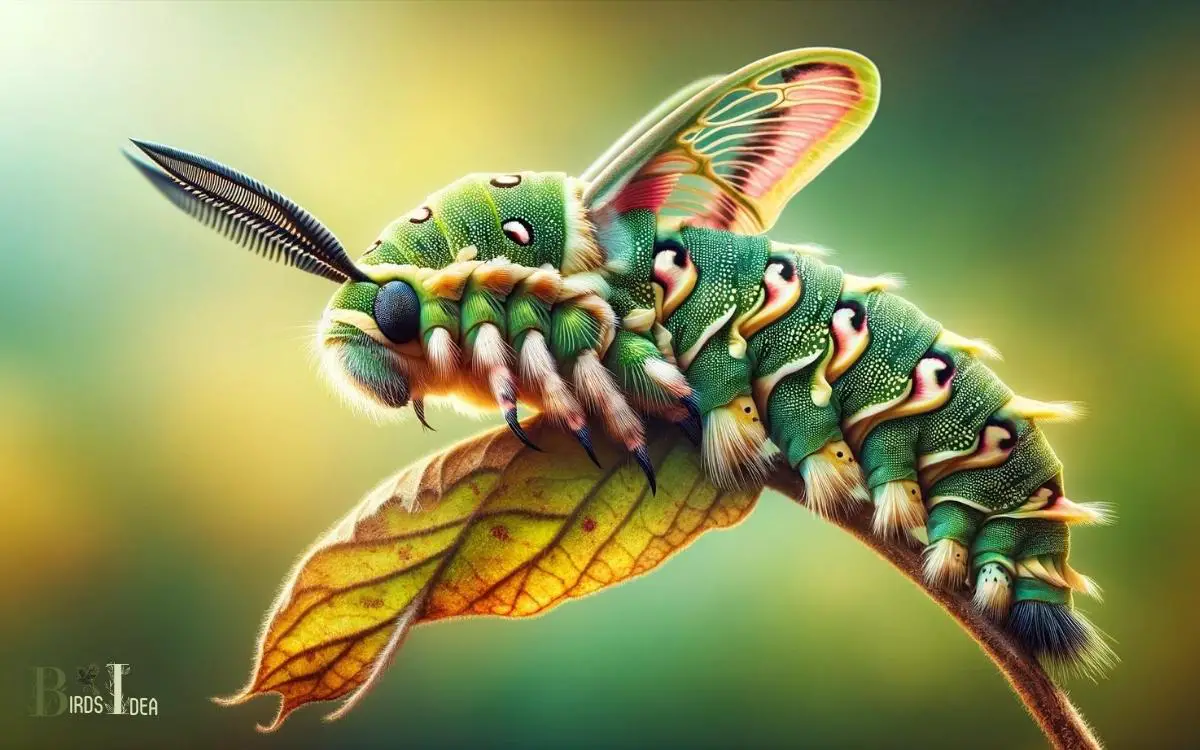
Key Takeaway
Hummingbird Moth Caterpillar Lifecycle
| Life Stage | Description |
|---|---|
| Egg | Small, spherical, laid on host plants. |
| Larva (Caterpillar) | Bright green, white stripes, horn-like tail, up to 4 inches. |
| Molting Phases | Sheds skin to grow, several times during the larva stage. |
| Pupa (Cocoon) | Transition stage where metamorphosis occurs. |
| Adult (Hummingbird Moth) | Resembles a hummingbird, capable of hovering while feeding. |
The Life Cycle of the Hummingbird Moth
Emerging from its egg, the hummingbird moth caterpillar begins its remarkable life cycle, transforming through several stages before reaching adulthood.
The first stage is the larval phase, where the caterpillar hatches and starts feeding on plant leaves. As it grows, the caterpillar sheds its exoskeleton multiple times in a process called molting.
Each molt reveals a larger, more developed caterpillar. After reaching the final larval stage, the caterpillar enters the pupal phase, forming a protective cocoon around itself.
Within this cocoon, the caterpillar undergoes metamorphosis, eventually emerging as an adult hummingbird moth.
This transformation from egg to adult is a testament to the resilience and adaptability of the hummingbird moth caterpillar.
This remarkable life cycle leads to the development of unique characteristics in the hummingbird moth caterpillar.
Characteristics of the Hummingbird Moth Caterpillar
During the larval phase, the hummingbird moth caterpillar displays distinct physical characteristics as it feeds and molts to reach maturity.
The following table outlines the key characteristics of the hummingbird moth caterpillar:
| Characteristic | Description |
|---|---|
| Coloration | Initially green, the caterpillar may change to brown or yellow as it matures. |
| Body Structure | The caterpillar has a cylindrical body with several segments, each bearing short, stiff hairs. |
| Size | It starts small, around 1 cm in length, and grows to about 5 cm before entering the pupal stage. |
The hummingbird moth caterpillar’s distinctive appearance and growth patterns make it an intriguing subject for observation during its development into a mature moth.
Habitat and Diet of the Caterpillar
The hummingbird moth caterpillar prefers to inhabit areas with ample vegetation and a food source, feeding primarily on the nectar of various flowering plants.
They’re commonly found in meadows, gardens, and other open areas with abundant wildflowers.
The caterpillar’s diet primarily consists of nectar from a variety of flowering plants, including honeysuckle, phlox, and bee balm. It also feeds on the leaves of plants such as evening primrose and willow weed.
The caterpillar’s habitat is characterized by its need for a diverse range of nectar-producing plants. This allows the caterpillar to obtain the necessary nutrients for its growth and development.
The availability of suitable vegetation and nectar sources plays a significant role in the survival and population of the hummingbird moth caterpillar.
Behaviors and Adaptations During Caterpillar Stage
Adapting to its habitat and diet, the hummingbird moth caterpillar exhibits specific behaviors and adaptations during its growth stage, ensuring its successful transition into the next life cycle phase.
The caterpillar displays remarkable behaviors such as camouflaging itself within the foliage, minimizing the risk of predation.
It also demonstrates a remarkable adaptation by consuming toxic plants, storing the toxins in its body, and using them as a defense mechanism against predators.
This is achieved through specialized enzymes that break down the toxins and render them harmless to the caterpillar.
Furthermore, the caterpillar exhibits a unique behavior of molting its exoskeleton multiple times as it grows, enabling it to accommodate its increasing size.
These behaviors and adaptations are crucial for the caterpillar’s survival and transformation into a pupa.
These behaviors and adaptations play a vital role in the caterpillar’s survival and transformation into a pupa, where it will undergo further changes.
Now, it’s important to delve into the predators and threats that the caterpillar faces in its environment.
Can you Explain the Life Cycle of the Hummingbird Moth, from Caterpillar to Adult?
The sphinx moth transformation process is a fascinating journey from caterpillar to adult for the hummingbird moth. After hatching from eggs, the caterpillar goes through several molts before pupating. The pupa then transforms into an adult moth, resembling a hummingbird in flight. This process is truly a wonder of nature.
Predators and Threats to the Caterpillar
Predators pose a significant threat to the hummingbird moth caterpillar during its growth stage. Common predators include birds, wasps, and other insects.
The caterpillar’s bright coloration serves as a warning to potential predators, indicating that it’s toxic or unpalatable.
Additionally, the caterpillar exhibits behaviors such as rapid movements and hiding in the foliage to evade predators.
However, despite these adaptations, the caterpillar faces significant risks during its vulnerable stage.
Birds, with their keen eyesight, pose a constant danger to the caterpillar as they forage for food. Wasps are also a formidable threat, as they actively hunt for caterpillars to feed to their young.
The caterpillar’s survival hinges on its ability to evade these predators while it undergoes metamorphosis into its adult form.
Conclusion
The caterpillar stage of the hummingbird moth’s life cycle is marked by a period of remarkable growth and adaptation.
Despite facing various predators and threats, the caterpillar employs a range of behaviors and physical adaptations to ensure its survival.
Their habitat and diet play a crucial role in their development, and their ability to thrive in diverse environments is truly impressive.
Overall, the hummingbird moth caterpillar is a fascinating and resilient creature worthy of admiration.


